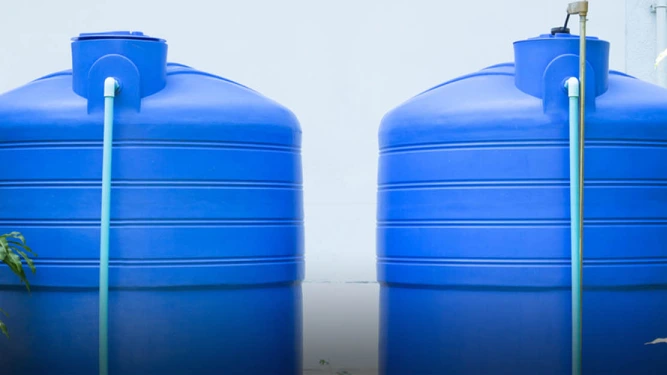Using water correctly and efficiently is essential for life. When water cuts occur during usage, unfortunately, every aspect of life is affected. Therefore, a water tank, which is an important option, provides the storage of water in the right amount and in the right way. However, since there are tons of water inside, it is crucial to protect it against external factors. For this reason, water tank insulation is preferred. So, how should water tank insulation be done? We will now talk about all the details of this subject.
 What is a Water Tank?
What is a Water Tank?
Structures designed to store water with different characteristics for different purposes and to use them in the future are called water tanks. Since there are different types of water tanks according to their usage purposes, they are preferred in cases where it is difficult to access water. Moreover, there are many different types of water tanks today, such as polyethylene water tanks, polyester water tanks, stainless steel tanks, and reinforced tanks. For this reason, tanks that will serve the purpose and ensure the proper use of water must be produced. However, the insulation process that will protect the water against external factors must also be controlled after this.
What is Water Tank Insulation?
Water tanks, which are produced with different materials in different ways, enable the use of water to meet the needs at certain times. Thus, the necessary water can be supplied even if there is a cut, and the storage of water can be ensured within a certain period. However, insulation of the water tank is necessary to protect the water from external factors. So, what exactly does it mean?
If there is a leak in the water tank, different external factors mix with the water or cannot be protected in a clean way, water tank insulation is carried out. Thanks to this insulation work, any external factor is prevented from affecting the tank. If insulation and cleaning works are not carried out periodically and necessary arrangements are not made, rust, dirt, or different foreign substances can mix with the water in the tank. In addition, the insulation process must be carried out by considering certain steps.
How to Insulate a Water Tank?
The materials used in the tank design and construction stage determine the type of the tank. This situation will also affect the course of the insulation process to be carried out. However, the first step should always be the cleaning of the tank. Thus, the cleaning steps of the tank are successfully carried out, and then the insulation work begins. The insulation process proceeds as follows:
The insulation process of water tanks produced with materials such as polyethylene, concrete, sheet metal, galvanized, and polyester is different for each. Insulation works must be carried out with the material for which it is produced.
Since formations such as rust, dirt, mud, and algae may occur inside the tank, the internal cleaning of the tank should be carried out initially using special materials.
Then, special mixtures prepared to prevent harmful bacteria from reaching the inside of the tank are applied to the inner surface of the tank in a way that will not harm the water or health. After the application, a certain waiting period is required for the material to dry and bond to the surface of the tank.
After the insulation material is completely dried, a water test is performed in the tank. Thus, it is checked whether there is a problem with the insulation or any leakage.
As a result, water tank insulation should be carried out periodically to protect the water stored in the tank against external factors and to ensure that it is used correctly.
What are the insulation materials for water tanks?
The main purpose of insulation is to protect against external factors and increase durability. Therefore, materials used in water tank insulation should be selected accordingly. For example, concrete insulation materials should not be used in the insulation process of a polyester water tank. Otherwise, effective insulation will not be achieved, and additional material and moral losses may occur. It is also essential to seek support from expert companies when selecting the insulation material for the water tank. Otherwise, irreversible losses may arise for you.
What Should Be Considered in Water Tank Insulation?
Various changes may occur in insulation depending on the tank capacity. Another factor that affects this is the material used. Therefore, pre-analysis is crucial, whether it is a 1-ton water tank or a 5-ton water tank. After the analyses are performed, the negative conditions in the tank are listed, and the appropriate insulation material must be selected. In the insulation process;
- The special insulation mortar should be applied in two layers,
- Necessary cleaning should be performed before applying the mortar, and
- It is essential to let it dry for the required time.
Through water tank insulation works carried out by paying attention to the three main factors mentioned above, the water and human health in the tank can be kept under control. Karmod Plastik, which provides you with professional services with its superior technological infrastructure, will ensure that you receive the most accurate insulation service. We are ending our content "How Should Water Tank Insulation be Done?" here. If you also want to receive insulation service, you can contact us and learn all the relevant details.


 EN
EN
 DE
DE
 FR
FR
 IT
IT
 ES
ES
 PT
PT
 RU
RU
 AR
AR
 BG
BG
 SR
SR
 GR
GR
 SQ
SQ
 RO
RO
 PL
PL
 HU
HU
 CZ
CZ
 HR
HR
 AZ
AZ
 GE
GE
 AM
AM
 IL
IL